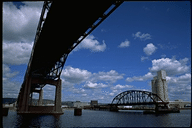
by Philip Greenspun; created 1993-1996
Home : Travel : Great Trips : Nice People and the Guy who Hated Them
Start in Thunder Bay, Ontario, on the northwest edge of Lake Superior. Drive
southwest on US 61 for 150 miles along one of America's prettiest shorelines.
Stay the night in the resort town of Grand Marais so that you can really explore
the cliffs rising hundreds of feet from the lake and the trails in the forest on
the other side of the road. Brake for moose.

"Duluth! the word fell upon my ear with a peculiar and indescribable charm, like the gentle murmur of a low fountain stealing forth in the midst of roses; or the soft, sweet accents of an angel's whisper in the bright, joyous dream of sleeping innocence."
--- James Proctor Knott, in the House of Representatives, 1871
Start with a boat tour of the harbor in Duluth, Minnesota. Marvel at the vast quantities of grain, iron ore, and coal being transferred from railroads to boats bound for the other side of Lake Superior and beyond.
 When I did the cruise in 1993, Kirk, a good looking Scandinavian-American college
kid, filled me in on life in his hometown.
When I did the cruise in 1993, Kirk, a good looking Scandinavian-American college
kid, filled me in on life in his hometown.
"Lake Superior is 400 miles long. Even now the water isn't above 37 degrees. When the wind comes off that water, you get a wind-chill of -100. The economy is dead flat due to the collapse in iron ore mining. Once I finish my manufacturing management degree, I'm moving to Colorado."
Why Colorado?
"I lived there for one year in high school and it beats Hell out of Duluth."
Town Babbitts are not giving up without a fight. They spent $20 million to build a container handling terminal; it was used once for a demonstration ten years ago. They spent $15 million for a fine convention center; it is in Duluth. They turned a brewery on the lake into a Ghiradelli-Square upscale shopping mall clone; it was empty.
Duluth per se may be a little down at the heels, but it sits at
Cruise down I-35 through a flat wooded landscape, broken up only by occasional enormous Indian-owned casinos. After a couple of hours, the Twin Cities rise up like Oz out of the bleak flat landscape, "divided by the Mississippi River and united by the belief that the inhabitants of the other side of the river are inferior."
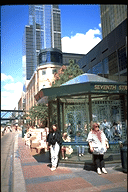 Minneapolis went whole hog for mirrored-glass megaliths, which isn't so bad; Mies
van der Rohe looks a lot better after staring at trees, trees, and more trees.
Everything works here to an appalling degree. Bus shelters are beautiful glass
gazebos with piped-in classical music. Buses run on time.
Minneapolis went whole hog for mirrored-glass megaliths, which isn't so bad; Mies
van der Rohe looks a lot better after staring at trees, trees, and more trees.
Everything works here to an appalling degree. Bus shelters are beautiful glass
gazebos with piped-in classical music. Buses run on time.
This is an UnCity in many ways. A fundamental difference between village life and city life is that primary relationships are replaced with functional relationships. In the village you buy your food from Bob, whom you've known since childhood, who happens to be working in the supermarket. In the city you buy your food from a supermarket clerk whom you could see every day and never learn his name. Minneapolitans haven't understood this. When you walk into a store or a restaurant, people say hello to you, unlike in Boston where they'd wait for you to approach them and attempt to transact business. Here you relate as people first, as consumer and vendor second.
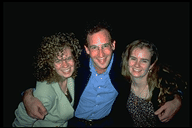 Moll
Flanders would have had a delightful time here: natives are woefully unprepared
for the sort of malevolent self-invention that is possible in cities. I ran into
two sisters. Amy had lived her whole life in Minneapolis; she invited me to come
visit the next day and go sailing. Her sister Paula, though so clear of eye and
smooth of skin that it would be difficult to believe that anything bad had ever
happened to her, had been schooled in suspicion and human evil at Harvard Law
School. She remembered an intangible obligation for the benefit of her naive
sister and nixed the invitation.
Moll
Flanders would have had a delightful time here: natives are woefully unprepared
for the sort of malevolent self-invention that is possible in cities. I ran into
two sisters. Amy had lived her whole life in Minneapolis; she invited me to come
visit the next day and go sailing. Her sister Paula, though so clear of eye and
smooth of skin that it would be difficult to believe that anything bad had ever
happened to her, had been schooled in suspicion and human evil at Harvard Law
School. She remembered an intangible obligation for the benefit of her naive
sister and nixed the invitation.
I ate breakfast with Al, an attorney from Boston. "I came out here to work for the attorney general for a summer and then decided to settle here. What shocked me about Minneapolis was that people had faith in the system. No assumptions were made about the kinds of people who were arrested. It wasn't just the prosecutor's office or the judicial system. People believe in the government school system here."
Speaking of breakfast, Minneapolis is not the place to stick to your tofu and chlorophyll diet. Try some blueberry pancakes and bacon at Al's Breakfast, 413 14th St. SE. If at dinner time the blood cells are still managing to make it one-by-one through your aorta, visit Murray's on 26 S. Sixth St. for one of the 2" slabs of corn-fed beef that they've been serving since 1933.
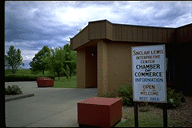 If you want to be reminded of America's Calvinist heritage, head northwest on
I-94 to Sauk Centre. Calvinists take seriously the notion that ultimate judgment
is reserved for God. We might be convinced that we are right, but there is always
a trace of doubt. This kept anyone from being beheaded in the American Revolution
(contrast that with the revolution in humanist France). On the other hand,
sometimes showing both sides of the coin leads to bizarre results. In Germany,
I'd sometimes asked why there weren't any Nazi museums and people said "don't be
ridiculous; why would we promote something we should be ashamed of?" Folks in
Sauk Centre just wouldn't understand this.
If you want to be reminded of America's Calvinist heritage, head northwest on
I-94 to Sauk Centre. Calvinists take seriously the notion that ultimate judgment
is reserved for God. We might be convinced that we are right, but there is always
a trace of doubt. This kept anyone from being beheaded in the American Revolution
(contrast that with the revolution in humanist France). On the other hand,
sometimes showing both sides of the coin leads to bizarre results. In Germany,
I'd sometimes asked why there weren't any Nazi museums and people said "don't be
ridiculous; why would we promote something we should be ashamed of?" Folks in
Sauk Centre just wouldn't understand this.
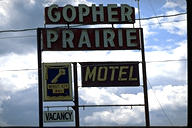 Any town might be proud of a son who won the 1930 Nobel Prize for literature (the
first American to do so). But what if he won that prize by writing Main
Street, a book about how venal and narrow-minded the townspeople of "Gopher
Prairie" are? Sinclair Lewis was born here in 1885 and left to go to Yale, travel
the world, and settle in New York. His boyhood home is now on Sinclair Lewis
Avenue. Main Street has been renamed Original Main Street.
Any town might be proud of a son who won the 1930 Nobel Prize for literature (the
first American to do so). But what if he won that prize by writing Main
Street, a book about how venal and narrow-minded the townspeople of "Gopher
Prairie" are? Sinclair Lewis was born here in 1885 and left to go to Yale, travel
the world, and settle in New York. His boyhood home is now on Sinclair Lewis
Avenue. Main Street has been renamed Original Main Street.
"I thought Sinclair Lewis had particular scorn for the kinds of boosters who formed the Chamber of Commerce. How come they built this nice highway rest stop for their most vicious satirist?" I asked the woman running a biographical video at the Chamber of Commerce Sinclair Lewis Interpretive Center.
"I don't know. I haven't read any of his books."
Continue on I-94 to Alexandria to see the Kensington Runestone, found on Olaf Ohman's farm in 1898. The stone's inscription relates a story of Viking explorers slaughtered by Indians in 1362. Although never lost like the Book of Mormon gold plates, the stone's authenticity has been oft ridiculed. Nonetheless, Alexandria boasts a 26-ton replica of the stone, 1 mile east on SR 27.
Strike out north to Lake Itasca, the source of the Mississippi River. Follow the river northeast for the first 30 out of its 2,350 miles. You'll roll through pine and birch forest over gravel roads that cross and recross the meandering stream with its beaver dams. Get detailed directions from locals or be prepared to try out a lot of dead ends.
At Bemidji, the first town on the river, head east on US 2 to Grand Rapids, the first place on the river that you could reasonably navigate. Despite its popularity with the Minnesota State Bird (the mosquito), you won't want to miss the U.S. Grand National Chainsaw Sculpturing Championships in early August. If you can't be there in August but still want to see some violence done to trees, take the Blandin Paper Mill tour (MWF in summer, 9-4; (218) 327-6226).
Continue east to Hibbing, birthplace of Bob Dylan and the Greyhound Bus company. The downtown Greyhound Origin Center has exhibits of model buses and such. Head a couple of miles north to the Hill-Rust Mahoning Mine, a 3 mile by 2 mile open pit iron ore mine, one of the largest in the world. If you like the mine, you'll love driving up US 169 to Ironworld USA in Chisholm. It is the world's only amusement park adjacent to an open pit mine. Continue on 169 to Soudan Underground Mine State Park, 2,400' underground.
By now you've probably seen enough despoilation, so head north to Voyageurs National Park to canoe the Boundary Waters.
If you are actually planning to take this trip, you may wish to look at the user-contributed Related Links page.
Return
to the Great Trips index page
Text and pictures copyright 1993-1996 Philip Greenspun